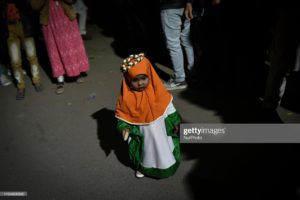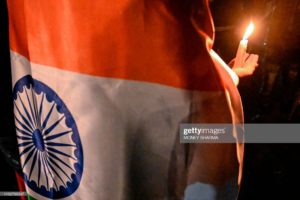As well as Australia Day, 26 January is an important day of celebration in India as Republic Day. The Constitution of India formally came into force on 26 January 1950.
While Australians seem more divided each year about the appropriateness of celebrating a day on which our original inhabitants were invaded, conquered and dispossessed, in India this year there is a mass awakening to the critical importance of the social purposes of the state of India embodied in the Constitution that is without precedent in the 70 years of the existence of the Republic.
The ‘Othering’ of India’s Muslims by Hindu bigots has depended on questioning their loyalty and allegiance to India and attempting to portray them as fifth columnists loyal to the Islamic Republic of Pakistan. That underlying suspicion has been harvested politically by PM Narendra Modi’s Bharatiya Janata Party (BJP) to push through a social agenda that has steadily marginalised the Muslims and promoted Hindus as more equal than others. It came to a head with the passage of an amended citizenship law in December and will be taken further with two additional measures this year. The moves have spawned a spontaneous mass protest by young Indians. I am not aware of any other democratic country that has experienced any comparable mass mobilisation in defence of its core democratic identity against the freely elected government. To underline the significance, it’s worth remembering that India is the world’s biggest democracy, and then some: the size of its electorate is bigger than all the Western countries combined. Just the number of Indian Muslim voters exceeds the total number of voters in all Western countries other than the US. The article below from The Indian Express must be read against this backdrop.
Ramesh Thakur, ANU

The English-speaking urban youth usually ring in the new year in Delhi with their socio-economic equals in stratified environs of clubs, pubs, restaurants and homes. But this new year’s eve, it was at radically different places — on the road outside the Jamia Millia Islamia University or at Shaheen Bagh — two of the most iconic places linked with the recent civic protests against the CAA [Citizenship Amendment Act]and NRC [National Register of Citizens]. Here they mingled freely with people they would rarely interact with as equals, and that too, in a public space.
If that was not radical enough, what happened at the midnight hour was a moment that portends something significant for India in the coming decade. As the clock struck 12, those gathered there broke into the national anthem. Never has any public gathering in post-Independent India witnessed such a passionate singing of the national anthem, not even after a major sports victory when patriotism and nationalism are usually at their apogee.
The singing of the national anthem by the people at Shaheen Bagh or outside Jamia took no one by surprise. From the day they started, these civic protests were marked by lusty wavings of the national tricolour, public readings of the Preamble to the Constitution, and now, the singing of the national anthem. Cynics can allege that this was part of a tactical ploy by the protestors to shield themselves from being labelled “anti-national”. But that argument is rebutted by the fact that these protests, all over the country, are neither centrally directed nor centrally organised. In fact, it is not unusual to witness multiple protests by various groups at the same site, merging and demerging at the same time, ruling out any possibility of a devious diktat by a central authority for everyone to flaunt the national symbols.
The presence of national symbols and icons is simultaneously marked by an absence of religious and sectarian symbols, even though the issue directly affects the Muslim community. This is not coincidental, but points to a critical shift in the form and manner of civic protests and democratic engagement in India’s public spaces.
How does a group of citizens perceive, articulate and negotiate their citizenship claim? The young Muslim, who has been the ideological and organisational fountainhead of these protests in her community, has not chosen religion or community as a means of intermediation with India’s democracy. She has instead chosen the Constitution as the instrument to engage with the democratic setup and assert her citizenship as an Indian, without sacrificing her Muslim identity.

It is this wilful choice which makes the tricolour and the national anthem such a natural fit in these protests, unlike a forced effort to place a tricolour among a sea of party or religious flags. Moreover, the Constitution, as the intermediary, has provided the metaphor for members of all classes, castes, communities and demographics to join these protests — these larger solidarities are at the heart of the optimism, creativity and enthusiasm witnessed on the streets. It reinforces the political argument that citizenship and democracy belong together — naturally compatible and mutually complementary.
Every single dimension of the concept of citizenship is being challenged by the CAA-NRC regime of the Narendra Modi government: Citizenship as a legal status, citizenship as a bundle of rights and entitlements, and citizenship as a sense of identity and belonging. While the government officials want to restrict the contestation to one of a legal status, the ruling party politicians are keen to limit it to that of the Muslim identity. A negotiation of the idea of citizenship is inherently full of tensions and contradictions. But by placing the Constitution at the centre of the public space and the national debate, the young have involved all the aspects and expanded it to a larger question about the kind of India that they want, defeating all attempts to limit it either only to the victimisation of Muslims or to a legal contest over a new law.
There is a sharp distinction between citizenship obtained through struggle and citizenship as a gift of the state. In India, the idea of citizenship evolved at the end of a prolonged struggle for the country’s freedom, forging it with the idea of India. The idea of a civic struggle for citizenship has thus been intricately linked with the idea of India, which also fits in with the modern liberal discourse of civil and political rights. National symbols — the tricolour, the preamble and the national anthem — are situated at the confluence of these ideas, and the young have started their march towards reclaiming the idea of India by reclaiming the national symbols of India.
This is a generation accused of being consumed by a sense of self, often damned for not venturing beyond their own headphones. But, by clearly identifying the burden that the CAA-NRC regime would place on each individual, they have made people realise and understand what the Constitution means to each and every person.
Reclaiming national symbols, while bringing life to an abstract idea like the Constitution, is an act of political genius and imagination. Any idea becomes a force when it connects to the self. This idea has brought the young Indian to the street. Its power cannot be estimated as yet. It would be a difficult beast to tame.
Ramesh Thakur is emeritus professor at the Australian National University and a former United Nations Assistant Secretary-General. Of Indian origin, he is a citizen of Canada, New Zealand and Australia.

Comments
4 responses to “SUSHANT SINGH. With a flag, song and book (Indian Express 24-1-20)”
I have posted this on Politavist: https://www.facebook.com/politavist/posts/843645066106354?comment_id=843647342772793¬if_id=1580013810603236¬if_t=feed_comment
Reason: the youth of India will, I hope, help inspire the youth of Australia to tackle some profound constitutional problems that we face.
Thank you Sushant Singh. You lend us deeper hope.
Perhaps India offers an example to Australia. We have a Constitution and the next Parliament could move Australia Day to 1 January. We could keep 26 January for those who celebrate the arrival of the British Empire and have an inclusive party. We could make Wattle Day a public holiday for those upset by losing the day off on 26 January and have another party with more plants, flowers and hopefully water. The national Anthem has words we have left behind eg sharing lands ? So we can go with the ABC and sing “we are one etc”. And yes we need a new flag. So invite submissions and await a Cabinet decision. I like some green and gold but I like what we have and the indigenous flag. As a lawyer I hope for the Rule of Law that is losing its grip here. I hope for the best soon.
Michael – have a look. Not just at my own response to this article but an example of what could be:
https://scontent-syd2-1.xx.fbcdn.net/v/t31.0-0/p280x280/10834859_525338250937886_1452788636283202603_o.jpg?_nc_cat=110&_nc_oc=AQkk3RgjH97zx6yLKDkbRsf2x0ySTbFptTjRlkYv0pN-jm1wZi-pzhws0MV0s034_xc&_nc_ht=scontent-syd2-1.xx&_nc_tp=6&oh=7bfd76273a2589b8a326c24a17973cab&oe=5E9C13BD
If liberalism, undermined by its individualist foundations, is collapsing in the countries of its birth, what hope has it in India? Secularism solves the problem of division on religious lines, but a secular state dependent on “modern liberal discourse of civil and political rights” may also fail, and may already have done so, as suggested by the decline of the Congress Party. The Singapore leadership, who are brighter than the rest of us, were never keen on that liberal shibboleth, laissez-faire electoral democracy, because they thought the administration would degenerate into a squabbling mess poisoned by communal division. India’s liberal secularism seems to have ended, not so much in squabbling, as in tyranny of the majority. It is hard to imagine that kind of oppression festering for long without provoking war with Pakistan and Bangladesh.